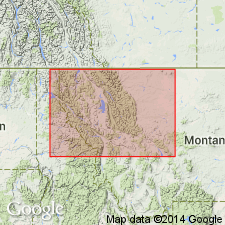
- Usage in publication:
-
- Hell Roaring member
- Modifications:
-
- First used
- Dominant lithology:
-
- Dolomite
- Limestone
- AAPG geologic province:
-
- Northern Rocky Mountain region
Summary:
First published use as middle member of Altyn formation of Ravalli group of Belt series. Was called lower member of Altyn by Willis (1902). Type locality is at Hell Roaring Falls, Waterton Lakes Park, AT, Canada in Northern Rocky Mountain region. Is also well exposed on Mt. Carthew in the Waterton Lakes Park. Composed of blue- to green-gray dolomite and dolomitic limestone in beds 2 to 24 in thick associated with biostromes of COLLENIA ALBERTENSIS. Estimated to be 1,200 to 1,300 ft thick. Contact with underlying Waterton member (rank reduced) of Altyn marked by change from dull red to blue gray. Thinning of beds and diminution of dolomite. Underlies Carthew member (new) of Altyn. Of pre-Cambrian age. Correlation chart.
Source: GNU records (USGS DDS-6; Denver GNULEX).

- Usage in publication:
-
- Hell Roaring member
- Modifications:
-
- Not used
Summary:
Hell Roaring member, Middle Member of the Altyn formation of Fenton and Fenton (1937) corresponds to the Altyn limestone as originally described by Willis (1902). Willis' Altyn had a lower massive limestone with concretions 800 ft thick and an upper argillaceous ferruginous limestone 600 ft thick. His total thickness for the Altyn is close to the 1,200-1,300 ft that the Fentons assigned to their Hell Roaring member. Term Hell Roaring member not used on nomenclature charts or geologic maps.
Source: GNU records (USGS DDS-6; Denver GNULEX).
For more information, please contact Nancy Stamm, Geologic Names Committee Secretary.
Asterisk (*) indicates published by U.S. Geological Survey authors.
"No current usage" (†) implies that a name has been abandoned or has fallen into disuse. Former usage and, if known, replacement name given in parentheses ( ).
Slash (/) indicates name conflicts with nomenclatural guidelines (CSN, 1933; ACSN, 1961, 1970; NACSN, 1983, 2005, 2021). May be explained within brackets ([ ]).

